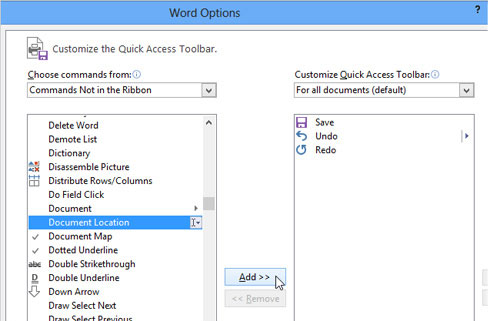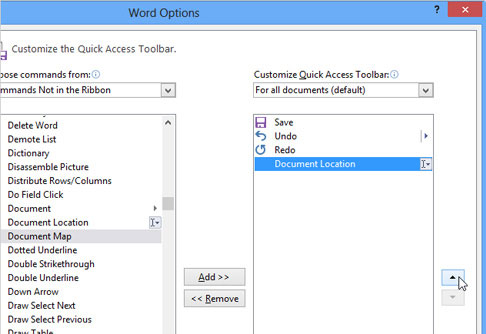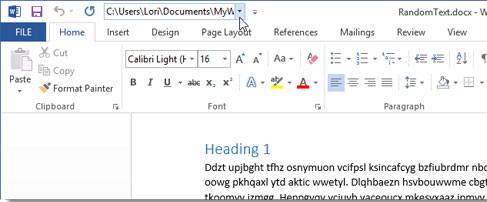Quickly identify file locations in Word 2013
The article explains how to quickly locate the file you are opening through the Quick Access Toolbar in Microsoft Word 2013.
During the compilation of Microsoft Word documents, you can forget where you saved the document in the device. In addition to using the ' Save As' command, you can quickly view the file location on the Quick Access Toolbar.

How to do the following:
Open any document or open a new Microsoft Word editing window, click the tab (card) 'FILE'.

Click 'Options' at the bottom of the options list on the left.

In the ' Word Options' dialog box , click on the 'Quick Access Toolbar' in the list of options on the left.

To reduce the options that appear to easily find the desired option, select ' Commands Not in the Ribbon' from the drop-down list in the ' Choose commands from' section .

Scroll down the list of commands until you find 'Document Location', click on it and click 'Add ' to add it to the Quick Access Toolbar.

You can move the Document Location button to another location in the Quick Access Toolbar using the arrow buttons. In the example in this article, the Document Location button is placed at the bottom of the toolbar, because the Document Location button is larger than the other nodes.

Click 'OK' to save and change the 'Word Options' dialog box .
You will see a ' Document Location' box with a drop-down list that appears on the Quick Access Toolbar and shows the path to the open document.

If you don't see the entire path in the Document Location box, click in the box and use the arrow keys to move the cursor to the end of the path.
You should read it
- Word 2013 Complete Guide (Part 3): How to store and share documents
- The text editing operations on Word 2013 are basic
- Align text, adjust font in Word 2013
- Word 2013 Complete Guide (Part 8): Using Indents and Tabs
- Word 2013 Complete Guide (Part 6): Aligning page layout
- Word 2013 Complete Guide (Part 10): Bullets, Numbering, Multilevel list in Microsoft Word
- Word 2013 Complete Guide (Part 7): Text printing operations
- Word 2013 Complete Guide (Part 11): How to create hyperlink links
May be interested
- How to convert Word to a CSV file
 if there is a data list in the word document, you can convert it into a csv file for inclusion in other applications.
if there is a data list in the word document, you can convert it into a csv file for inclusion in other applications. - 10 effective ways to fix corrupted Word files
 corrupt word files can be a major disruption to your workflow, especially if they contain important data. this can be caused by software, formatting, or operating system errors. this article will show you how to fix the error quickly and effectively, helping you recover the file content without complicated installation.
corrupt word files can be a major disruption to your workflow, especially if they contain important data. this can be caused by software, formatting, or operating system errors. this article will show you how to fix the error quickly and effectively, helping you recover the file content without complicated installation. - How to insert and copy PDF files into Word quickly and standardly
 when you receive the file or data in pdf format that you want to edit, or simply copy a paragraph in the pdf file but it is not done because the pdf file does not allow users to intervene to edit. so how to chu?
when you receive the file or data in pdf format that you want to edit, or simply copy a paragraph in the pdf file but it is not done because the pdf file does not allow users to intervene to edit. so how to chu? - Create a new Word file, open the file in Word 2013
 word files are called documents. whenever you start a new project in word, you will need to create a new document, which can be a new document or a sample text .
word files are called documents. whenever you start a new project in word, you will need to create a new document, which can be a new document or a sample text . - Tip to save all images in Word file out
 want to save all the images in your word file, but having too many images takes you too long? follow the following article to know how to save images in word files out extremely quickly.
want to save all the images in your word file, but having too many images takes you too long? follow the following article to know how to save images in word files out extremely quickly. - Watermark to Word file - Add Watermark to Doc file
 in word, you can stamp the 'copyright' into the content of word file, you can use that feature to determine your ownership of the word file.
in word, you can stamp the 'copyright' into the content of word file, you can use that feature to determine your ownership of the word file. - How to Convert Word Documents to HTML Format
 converting a .doc, .docx, or .odf file to html is simple, but there is no perfect method for completing this task. if you want to create a website that loads quickly and displays consistently across all browsers, you can use an online tool to convert word documents to html. if you want to store as many formats as possible, use word's built-in 'save as' function to convert this file.
converting a .doc, .docx, or .odf file to html is simple, but there is no perfect method for completing this task. if you want to create a website that loads quickly and displays consistently across all browsers, you can use an online tool to convert word documents to html. if you want to store as many formats as possible, use word's built-in 'save as' function to convert this file. - How to merge multiple Word files into a single file
 to merge multiple word files into a single file, we can immediately use the features available on this office tool.
to merge multiple word files into a single file, we can immediately use the features available on this office tool. - How to hide text from Word
 to secure certain important information in the text, we can hide the text and display it quickly when needed.
to secure certain important information in the text, we can hide the text and display it quickly when needed. - Instructions on how to create automatic table of contents in Word quickly 2020
 you have a long word document file, you want to create an automatic table of contents to make it easy to find the content in the file. so, please refer to the article on how to create automatic table of contents in word below.
you have a long word document file, you want to create an automatic table of contents to make it easy to find the content in the file. so, please refer to the article on how to create automatic table of contents in word below.










 Turn off the Mini Toolbar and Live Preview features in Word 2013
Turn off the Mini Toolbar and Live Preview features in Word 2013 How to open multiple spreadsheets side by side in Excel 2013
How to open multiple spreadsheets side by side in Excel 2013 Turn off text input on Word 2013
Turn off text input on Word 2013 Add captions to spreadsheets in Excel 2013
Add captions to spreadsheets in Excel 2013 How to add and edit shortcuts in Word 2013
How to add and edit shortcuts in Word 2013